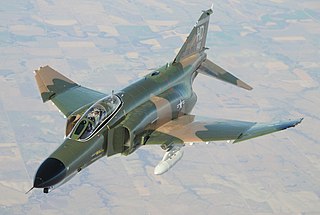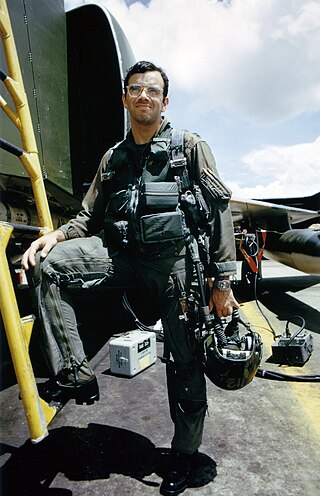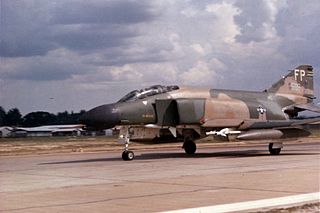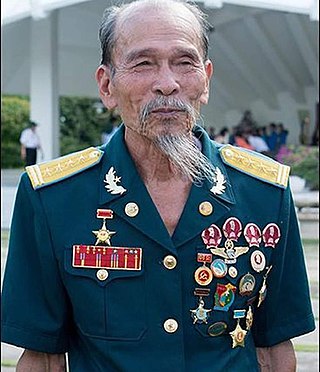
The McDonnell Douglas F-4 Phantom II is an American tandem two-seat, twin-engine, all-weather, long-range supersonic jet interceptor and fighter-bomber originally developed by McDonnell Aircraft for the United States Navy. Proving highly adaptable, it entered service with the Navy in 1961 before it was adopted by the United States Marine Corps and the United States Air Force, and by the mid-1960s it had become a major part of their air arms. Phantom production ran from 1958 to 1981 with a total of 5,195 aircraft built, making it the most produced American supersonic military aircraft in history, and cementing its position as a signature combat aircraft of the Cold War.

The Mikoyan-Gurevich MiG-17 is a high-subsonic fighter aircraft produced in the Soviet Union from 1952 and was operated by air forces internationally. The MiG-17 was license-built in China as the Shenyang J-5 and Poland as the PZL-Mielec Lim-6. The MiG-17 is still being used by the North Korean air force in the present day and has seen combat in the Middle East and Asia.

The USAF Air Demonstration Squadron ("Thunderbirds") is the air demonstration squadron of the United States Air Force (USAF). The Thunderbirds are assigned to the 57th Wing, and are based at Nellis Air Force Base, Nevada. Created 70 years ago in 1953, the USAF Thunderbirds are the third-oldest formal flying aerobatic team in the world, after the French Air Force Patrouille de France formed in 1931 and the United States Navy Blue Angels formed in 1946.

Wild Weasel is a code name given by the United States Air Force (USAF) to an aircraft of any type equipped with anti-radiation missiles and tasked with the suppression of enemy air defenses (SEAD): destroying the radar and surface-to-air missile (SAM) installations of enemy air defense systems. The task of a Wild Weasel aircraft is to bait enemy anti-aircraft defenses into targeting it with their radars, whereupon the radar waves are traced back to their source, allowing the Weasel or its teammates to precisely target it for destruction.

A light fighter or lightweight fighter is a fighter aircraft towards the low end of the practical range of weight, cost, and complexity over which fighters are fielded. The light or lightweight fighter retains carefully selected competitive features, in order to provide cost-effective design and performance.
This is a list of aviation-related events from 1967.

A tailhook, arresting hook, or arrester hook is a device attached to the empennage (rear) of some military fixed-wing aircraft. The hook is used to achieve rapid deceleration during routine landings aboard aircraft carrier flight decks at sea, or during emergency landings or aborted takeoffs at properly equipped airports.

Brigadier General James Robinson "Robbie" Risner was a fighter pilot in the United States Air Force, and a senior leader among U.S. prisoners of war during the Vietnam War.

A Weapon Systems Officer (WSO), nicknamed "Wizzo", is an air flight officer directly involved in all air operations and weapon systems of a military aircraft.
Nguyễn Văn Cốc is a former North Vietnamese MiG-21 fighter ace of the Vietnamese People's Air Force's 921st Fighter Regiment.

Jeffrey S. Feinstein is a retired career officer of the United States Air Force (USAF). During the Vietnam War, Feinstein was a weapon systems officer, an integral part of two-man aircrews with the emergence of air-to-air missiles as the primary weapons during aerial combat. Flying aboard F-4 Phantom IIs, Feinstein downed five enemy aircraft, thereby becoming a flying ace, the last of five U.S. aviators to become aces during that conflict and to date still the most recent aviator to achieve ace status in the U.S. military.
VFAX for Naval Fighter Attack Experimental was actually two specifications for two US Navy fighter projects. The first was for a low cost lightweight complement for the General Dynamics–Grumman F-111B which could replace the McDonnell F-4 Phantom II for air superiority, escort, and ground attack missions in the early 1960s. This role was dropped in favor of the VFX aircraft, which emerged as the F-14 Tomcat. The second VFAX evolved when the VFX proved too costly to replace all existing USN fighters and attack aircraft, and the Navy was invited to take part in the USAFs Lightweight Fighter Program (LWF). The Navy chose the YF-17, the loser of the LWF contest as its Navy Air Combat Fighter, as it was inherently more suitable to naval operations than the winning General Dynamics F-16 Fighting Falcon; it was redesigned to become the McDonnell Douglas F/A-18 Hornet.

Dissimilar air combat training (DACT) was introduced as a formal part of US air combat training after disappointing aerial combat exchange rates in the Vietnam War.
The Fighter Mafia was a controversial group of United States Air Force officers and civilian defense analysts who, in the 1960s and 1970s, advocated for fighter design criteria in opposition to those of the design boards of the time, and the use of John Boyd and Thomas P. Christie's energy-maneuverability (E-M) theory in designing fighter aircraft. The Mafia influenced the specifications for the F-X Program and went on to independently develop specifications for the Light Weight Fighter (LWF). Mafia member Harry Hillaker designed the purely air superiority day fighter prototype YF-16, which won the LWF contest but then turned into the multi-role fighter-bomber F-16 Fighting Falcon. The group's nickname, a professional jest coined by Everest Riccioni, an Air Force member of Italian heritage, was a rejoinder to the "Bomber Mafia".

Operation Bolo was a United States Air Force mission during the Vietnam War, considered to be a successful combat ruse.
The Thanh Hóa Bridge, spanning the Song Ma river, is situated 3 miles (4.8 km) northeast of Thanh Hóa, the capital of Thanh Hóa Province in Vietnam. The Vietnamese gave it the nickname Hàm Rồng. In 1965 during the Vietnam War, it was the objective of many attacks by US Air Force and US Navy aircraft which would fail to destroy the bridge until 1972, even after hundreds of attacks. The bridge was restored in 1973. As of 2016, the bridge still stands.

Nguyễn Văn Bảy, was a Vietnamese jet fighter ace for the Vietnam People's Air Force during the Vietnam War. Piloting a MiG-17F while assigned to the 923rd Fighter Regiment, Bay claimed 7 aerial combat victories while engaged against aircraft of the USAF and USN: 2 F-8s, 1 F-4B, 1 A-4C and 1 F-105D. Of the 7 claimed victories, 5 are acknowledged by American documents. Of 16 VPAF aces during Vietnam War, only Bay, Luu Huy Chao, and Le Hai solely flew MiG-17s.
The action of 23 August 1967 was a major air battle which involved elements of the Vietnam People's Air Force (VPAF) and the United States Air Force (USAF). The air battle took place over the skies of North Vietnam as part of Operation Rolling Thunder, during the Vietnam War.













